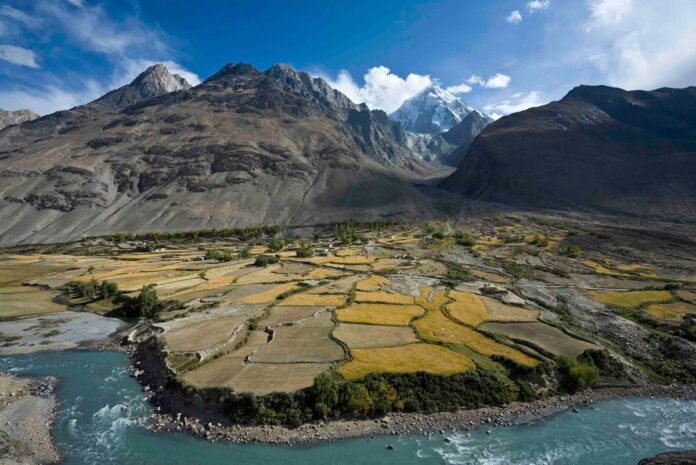The Wakhan Corridor, situated in Afghanistan’s Badakhshan Province, is a narrow land passage connecting Afghanistan to China through a mountainous 92-kilometer border while separating Tajikistan in the north from Pakistan in the south. Stretching 350 kilometers in length, it ranges in width from 16 to 64 kilometers.
Historically, the strip acted as a significant buffer between the British and Russian empires, and later between the Western-allied Pakistan and the Soviet Union. However, the corridor remains significant for regional connectivity in recent times, especially in light of China’s Belt and Road Initiative. Today, the Wakhan Corridor is the shortest trade route for Pakistan to access Central Asia and for China to establish direct connectivity with Afghanistan.
Despite its challenging geography, the Wakhan Corridor has historically been a peaceful region. The corridor offers potential for regional trade and integration, particularly under initiatives like the China-Pakistan Economic Corridor (CPEC).
Importance of Wakhan Corridor for China
Economic Significance
On January 2, 2024, Mullah Baradar, Deputy Prime Minister for Economic Affairs in the Taliban administration, announced that the construction of the road that connects Badakhshan to the Yarkand region of China of a length of 50 kilometers has been completed.
Baradar highlighted that the new road through Wakhan in Badakhshan Province is expected to establish a direct trade link between Afghanistan and China, thereby greatly enhancing bilateral trade opportunities. Taliban officials have underscored the geopolitical significance of the corridor, as it is positioned at a pivotal intersection of regional interests, potentially influencing broader dynamics in Central and South Asia.
For China, the opening of the Wakhan Corridor is a strategic milestone in its Belt and Road Initiative (BRI), providing direct access to Afghanistan while bypassing
intermediaries like Pakistan and Uzbekistan. This reduces trade costs and strengthens China’s economic foothold in the region. The corridor supports China’s investments in Afghanistan, including multi-billion-dollar projects to tap into lithium and copper deposits and infrastructure development in key provinces.
It also extends China’s reach into Central and South Asia, enhancing its influence and outpacing competitors like India and the U.S. in the region.
China’s economic engagement with Afghanistan has grown significantly since 2001, positioning China as one of Afghanistan’s primary trading partners and exporters. Key projects such as the $3.4 billion Aynak Copper mine, the world’s largest copper deal, and a $4 billion agreement focused on natural resource extraction underscore China’s long-term investment in Afghanistan.
After the trade route opens, all traffic from Afghanistan to China will be redirected through the Wakhan border, replacing the sea route and the Karakoram Highway. This route will become increasingly significant as China expands its mining operations in Afghanistan, tapping into precious and rare minerals. China has signed major agreements, including a $10 billion deal for access to Afghanistan’s lithium deposits and a $3 billion deal to develop the country’s largest copper deposit near Kabul. Additionally, China is exploring gold, lapis lazuli, and various gemstones in Badakhshan, copper reserves in Balkh, rare minerals in Helmand, and iron ores in Herat and Kandahar.
Geopolitical Significance
The Wakhan Corridor is essential for China’s broader geopolitical strategy. Geopolitically, the corridor could redefine trade routes across Central and South Asia, enhancing China’s influence and challenging U.S. and Indian regional objectives. Functioning as a modern Silk Road extension, the Wakhan Corridor embodies China’s dual priorities of economic expansion and regional stability, shaping the balance of power in Eurasia.
China’s strategic objectives include stabilizing Afghanistan through economic and security assistance. By opening the Afghan-China border via the Wakhan Corridor, China can establish a pivotal link between China, Central Asia, and the Gulf. To this end, China has invested in infrastructure development in the region, including constructing roads up to the Wakhjir Pass and building a supply terminal for its border police.
Strategic Significance
China’s engagement in the Wakhan Corridor has been cautious due to significant security concerns, particularly surrounding terrorism, human trafficking, and the flow of drugs.
From a security perspective, the corridor acts as a buffer zone to protect China’s sensitive Xinjiang region from threats like the East Turkestan Islamic Movement (ETIM). By coordinating security with the Taliban, China ensures stability along this critical trade route while addressing cross-border terrorism concerns. Thus, the Wakhan Corridor strengthens China’s dual goals of economic expansion and regional security, cementing its role as a dominant power in Afghanistan and beyond.
The Wakhan Corridor is becoming a strategic focal point for Afghanistan, China, and Pakistan. Initially resisted under President Karzai, the corridor gained momentum after Pakistan, with China’s backing, adjusted border demarcations in 2022, prompting Taliban intervention. China now actively invests in the corridor, integrating it into its Belt and Road Initiative (BRI) to secure trade routes, stabilize Afghanistan, and protect its Xinjiang region from extremist threats like ETIM.
The corridor could potentially serve as both an economic artery and a security buffer, enabling China to dominate trade in Afghanistan while sidelining competitors like India and Iran. With infrastructure development and resource exploration, such as the Amu Darya oil fields, China positions itself as a key partner for Afghanistan, balancing mutual distrust with strategic collaboration.
Conclusion
China’s growing involvement in the Wakhan Corridor represents a shift in the region’s geopolitical landscape, with China positioning itself as a dominant force in both economic and security matters. The corridor could serve as a critical link between Central Asia and China, offering significant trade, energy, and security advantages.
By investing in infrastructure and fostering regional cooperation, China aims to strengthen its presence while addressing its security concerns, particularly regarding extremist groups. As a result, the Wakhan Corridor is poised to become a key geopolitical and economic asset, reshaping the future of Central and South Asia.




